Glass flower pots for orchids are primarily necessary for decorative purposes. This function is not the only one, and not bad if there is such a pot. Glass transmits sunlight well, which is very important for the development of the plant. In addition, in stores you can find a large selection of volume and shape for the future pot. The glass container is stable unlike the plastic one, and the absence of pallets only goes hand in hand when the orchid needs to be frequently rearranged.
Content
Content in flasks
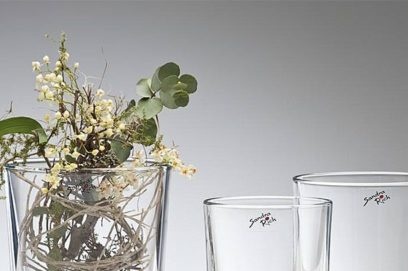 The difference is not only in their beautiful blossoms, but also in breeding methods. If many flowers grow on the ground, then orchids grow from the tree bark, clinging to it. They receive useful components and humidity by means of air roots. Moisture comes from air or fog, and useful components from their own residues, which accumulate in the bark of a tree. But such a process takes place in humid tropics, where the habitat for orchids is very suitable. In indoor conditions, it is impossible to create such an atmosphere. There is not one method how to grow an orchid:
The difference is not only in their beautiful blossoms, but also in breeding methods. If many flowers grow on the ground, then orchids grow from the tree bark, clinging to it. They receive useful components and humidity by means of air roots. Moisture comes from air or fog, and useful components from their own residues, which accumulate in the bark of a tree. But such a process takes place in humid tropics, where the habitat for orchids is very suitable. In indoor conditions, it is impossible to create such an atmosphere. There is not one method how to grow an orchid:
- cultivation in water - hydroponics;
- orchid without substrate and liquid;
- breeding in the soil.
If the roots of the plant are constantly in the liquid, then their decay will begin. Therefore, they should not be completely immersed, but should be above the liquid. It is not necessary to go directly to the content in the flask, especially for the flower itself:
- First you need to pull it out of the ground, clean the roots, lower it into water for a couple of days, and then dry it the next day. It is not necessary to drain the liquid completely, but so that the roots are still immersed in it for one centimeter.
- After a week, the orchid in the water can be left for several days, but one day should be allowed to dry.
- After, leave phalaenopsis in water for the whole time, changing it and observing the state of the roots. If they change color to silver, then the flower must be watered.
At this time, the growth of new aerial roots will be noticeable, and green shoots will begin to appear on the old ones.
If algae appeared on them, then you should not get rid of them, as this helps air exchange. A small part of the roots dies if the habitat has changed to aquatic, and instead of them appear those that are adapted for the plant to stay in water.
To prevent the appearance of the fungus, you need to use seven-hydroculture - an unusual substrate that does not give the flower any nutritional components, but keeps it in a standing position. The flower receives all food through fertilizers, which are diluted in water. They are easily absorbed, and therefore do not spend a lot of energy, directing it to development.
Landing in hydroponics
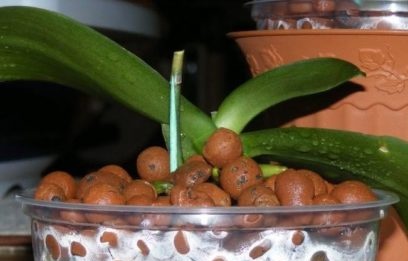 First you need to take a plastic pot with drainage holes, which are needed for the flow of water and other nutrients to the roots of the flower. If claydite is taken as soil, then before planting an orchid, its roots should be thoroughly washed from the old soil, and then dried. After, fill the pot half with expanded clay, plant a culture in it and fill it with soil to the very top.
First you need to take a plastic pot with drainage holes, which are needed for the flow of water and other nutrients to the roots of the flower. If claydite is taken as soil, then before planting an orchid, its roots should be thoroughly washed from the old soil, and then dried. After, fill the pot half with expanded clay, plant a culture in it and fill it with soil to the very top.
If claydite with perlite is used as soil, then expanded clay should be poured first, then a flower should be placed in it and poured with perlite on top. To strengthen such a mixture, lower the container into water.On top of the ground, you can add small pebbles that adorn the glass bottom of the aquarium.
If diatomite and expanded clay are used as soil, then diatomite should be poured first, then a flower should be placed in it and poured with expanded clay on top. To strengthen the mixture, the pot is also immersed in water.
Grow an orchid without soil perhaps semi-hydroculture is also used for this. Dip it in any transparent container and pour a little liquid, which under the influence of capillary forces rises to the roots, allowing them to be saturated with moisture and dissolved nutrients.
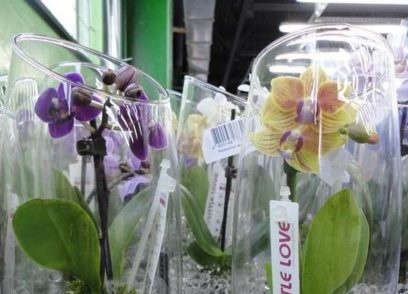 When a culture is planted in water, the roots are well ventilated above its surface. The flower is not attacked by those pests that would meet it in the soil, and it will not fade if there is a lot or a little fertilizing. Planted and grown culture in this way does not need transplants.
When a culture is planted in water, the roots are well ventilated above its surface. The flower is not attacked by those pests that would meet it in the soil, and it will not fade if there is a lot or a little fertilizing. Planted and grown culture in this way does not need transplants.
For orchid cultivation in water to be successful, you need to know that not all varieties are suitable for this. Many flower growers use those species that do not need a rest period and periodic drying of the root system:
- Phalaenopsis and other indoor varieties;
- Dendrobium, better growing in a cool room;
- Cattleya, she loves warm temperatures, but not heat;
- Zygopetalum.
Advantages and disadvantages of orchids in glass containers
When growing orchids in a vase, the nutrients penetrate the flower through the water much faster. This contributes to the fact that the flowers are formed large in size, 20 centimeters. Pros of orchids in water:
- You can immediately notice the decay of the root system, because the plant is in a glass vase, and not a closed pot. This is very important, as the plant often undergoes rot. Growing an orchid without soil allows it to access oxygen and provide circulation of water.
- Growing phalaenopsis is possible without transfers.
- Due to the fact that beneficial components are dissolved in water, the plant does not suffer from their excess or deficiency.
- An orchid without soil blooms well and develops, as it receives the right amount of nutrients, does not dry out.
But there are also disadvantages when growing in glass. However, there are very few of them, unlike landing in the ground:
- Check that the water is cool;
- Water should not be below the roots. If this happens, then the liquid should be added.
- It is necessary to feed the plant while it is growing.
- Constant care.
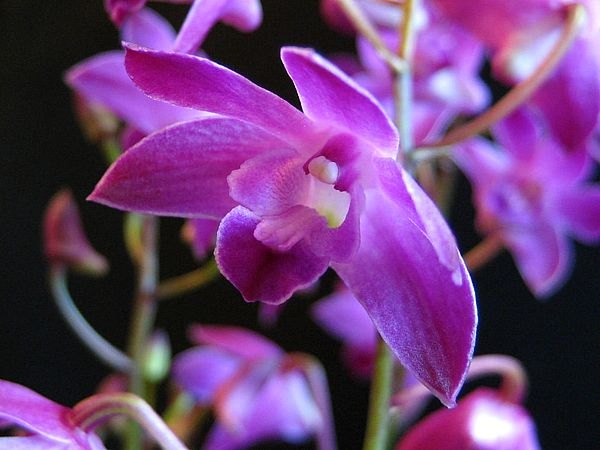 You may be interested in:
You may be interested in:Capacity requirements
Before as plant an orchid, you must select the pot in which this flower will be. This procedure is very important, as it depends on it whether the plant will survive or not. It is best to opt for transparent pots. This rule applies to all planting methods, including in water. Usually, they use plastic dishes that can be bought, or they find a bucket, hiding it behind a pot.
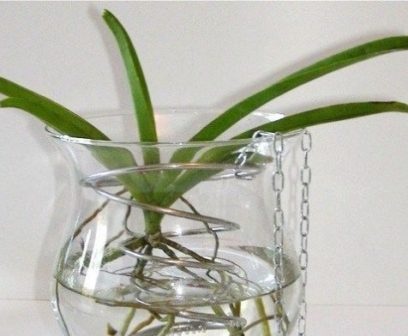 Is it possible to plant an orchid in a glass pot? Glass vessels are not suitable for growing phalaenopsis, because because of their cylindrical shape, the leaves acquire folds and soon break, which leads to the death of the flower. Including a high vessel prevents the flow of oxygen to the roots, causing them to rot.
Is it possible to plant an orchid in a glass pot? Glass vessels are not suitable for growing phalaenopsis, because because of their cylindrical shape, the leaves acquire folds and soon break, which leads to the death of the flower. Including a high vessel prevents the flow of oxygen to the roots, causing them to rot.
A suitable vase should have the shape of a glass. Before planting, in a vase, it must be taken into account that the flower must be on the outside and the root system inside.
Glass vases for orchids help the root system by giving it access to sunlight. But caring for plants in such vessels requires appropriate skill and experience, because you cannot make holes in them to drain water. Because of this, the flower will get waterlogging of the roots, which will not affect it very well. If the grower decided to grow phalaenopsis in a glass vase, then he must prepare the right drainage for this. However, it will be easiest to plant the plant in a plastic container, and put the pot in any vase.
One minus of the fact that the pot for the orchid is glass is that drainage holes cannot be made in it. Due to extremely high humidity, root decay can begin. If the glass bulb is high, this will help the orchid get more sunlight, but access to oxygen will be limited and this will adversely affect the overall development of the flower.
Care Features
Growing orchids without soil is not a common method for many gardeners and therefore planting in the soil is more popular.
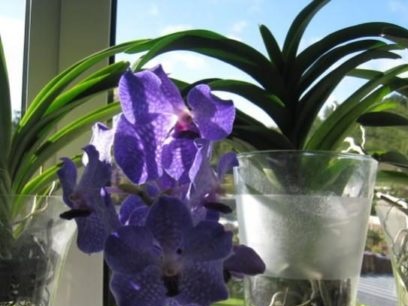 If we talk about flowers planted in water, then for this it is best to choose the type of Wanda. Conventional phalaenopsis can also be used, but in the wild, Wanda grows on trees or plants, saturated with moisture through rainwater. In order for an orchid in glass of this kind to grow at home, you need to maintain air humidity of at least 60%.
If we talk about flowers planted in water, then for this it is best to choose the type of Wanda. Conventional phalaenopsis can also be used, but in the wild, Wanda grows on trees or plants, saturated with moisture through rainwater. In order for an orchid in glass of this kind to grow at home, you need to maintain air humidity of at least 60%.
In order for an orchid to grow well in a vase without land, it is necessary to water it correctly and make sure that the water is at room temperature. Instead of watering, it is advisable to spray the soil, so that moisture will not get on the buds and leaves. Spraying should be based on air humidity.
If the orchid is in a glass flask, then it must be constantly and carefully looked after:
- In winter, the air temperature should be about 25 degrees. Reduce by 10 degrees if kidney formation is needed.
- Humidity must be maintained up to 75%. Because of this, orchid cultivation becomes problematic, because it is very difficult to recreate the necessary humidity. But for many species it is possible to maintain the indicator at 40%, since the orchid will take the missing moisture from evaporation due to high humidity.
- Orchid prefers fresh air, but do not install it in a ventilated place. In the summer, the flower can be placed on the balcony in the shade, where direct sunlight will not fall, as they can burn the leaves.
- Water with growing phalaenopsis is changed once every 3 days, and once a month the pot itself is well washed. During this, the roots of the plant are wiped, dried, and then lowered into a new solution.
- From time to time, the flower grows new leaves, but during this period does not bloom. To provoke flowering, you need to make a small difference in day and night temperatures.
 Water the orchid grown in a glass bowl in the same way as in a plastic pot:
Water the orchid grown in a glass bowl in the same way as in a plastic pot:
- It is necessary to add water to the roots so that they are completely immersed in it.
- Water itself must be infused to room temperature. It is important that it be free of impurities, or at least with a minimal amount.
In warm weather, water the plant 3 times a week, and in cool weather only once every seven days. But in hot weather, the frequency of watering can increase to daily. It is best to do it in the morning or at lunch, so that in the evening the orchid has time to dry.
When the orchid begins to grow leaves and grow actively, it must be fed with liquid fertilizers once a week according to the instructions. Before lowering the roots of the flower in a nutrient solution, they need to be dipped in water so that there is no burn. Such top dressing alternates with fertilizers for green mass from the spray gun.
Possible problems and difficulties
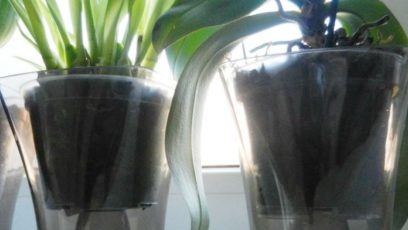 The main problem is primarily related to the frequency of watering: if there is a lot of it, then the roots begin to rot, and if not enough, the roots dry out. Spraying with fungicides will help against rot, but if it has moved to the trunk of a flower, then nothing will save it. It is easier to cope with dried roots, therefore, in no case should overflow be allowed.
The main problem is primarily related to the frequency of watering: if there is a lot of it, then the roots begin to rot, and if not enough, the roots dry out. Spraying with fungicides will help against rot, but if it has moved to the trunk of a flower, then nothing will save it. It is easier to cope with dried roots, therefore, in no case should overflow be allowed.
The second feature is the decorative culture. Due to impurities in the water, a plaque appears on the walls of the glass pot, which can be eliminated simply by washing it.
The third problem is that the orchid, like flowers planted in the ground, is attacked by pests and various insects. In glass containers, such also occur, but there are various ways to eliminate them.
The cause of many infections and diseases after planting an orchid in a glass pot is completed, is the accumulation of harmful bacteria. To get rid of them, the plant needs careful care at home. Since fungal infections develop in dark corners with high humidity, the flower should stand in a well-ventilated place.
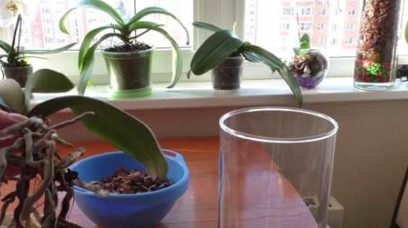 It is necessary that the vase with orchids is constantly ventilated and gain access to oxygen. This is important because it reduces the possibility of the development of fungi and bacteria, and the moist air inside the container does not stagnate for a long time. The content of orchids in suitable conditions also affects the development of the plant. To do this, you need to monitor the frequency of irrigation, air humidity and provide access to light.
It is necessary that the vase with orchids is constantly ventilated and gain access to oxygen. This is important because it reduces the possibility of the development of fungi and bacteria, and the moist air inside the container does not stagnate for a long time. The content of orchids in suitable conditions also affects the development of the plant. To do this, you need to monitor the frequency of irrigation, air humidity and provide access to light.
A large number of containers for any color and taste can be purchased at Ikea or Zara Home stores. But if in the first version you can find small flasks from 90 rubles, then in Zara Home the price for a medium-sized vase is 2000 rubles.
Glass pots for orchids are also found in specialized stores where you can buy a suitable container for 150 rubles. A large assortment from 300 to 700 rubles can be found in various online stores.
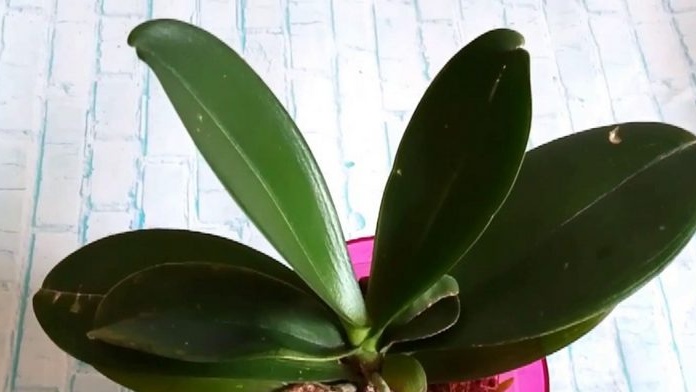 You may be interested in:
You may be interested in:To grow an orchid in glass containers, more and more lovers of these flowers are taking. Of course, they will look good in the interior of the house, but do not forget that, like any plants, orchids need appropriate care. The most important thing for them is the humidity, which should be at least 70%, otherwise the orchid roots begin to dry due to a lack of moisture in them. The only difficulty the grower may encounter may be transfer and choosing the right pot. They feed the plant with fertilizers just as if it was growing in the ground. When choosing an orchid pot, glass is a good option.

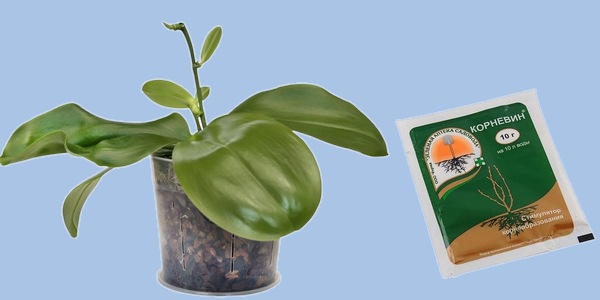
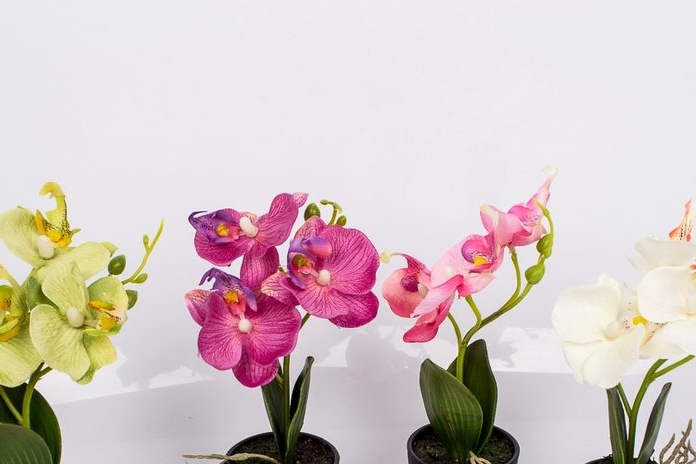
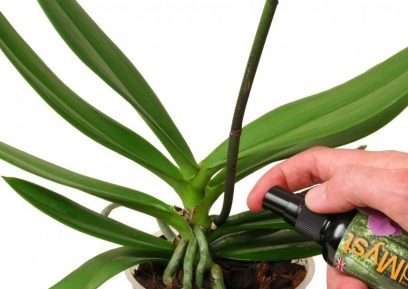
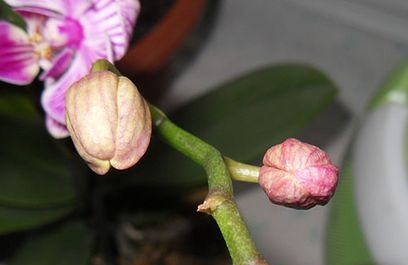 Reasons why orchids fall flowers and what to do
Reasons why orchids fall flowers and what to do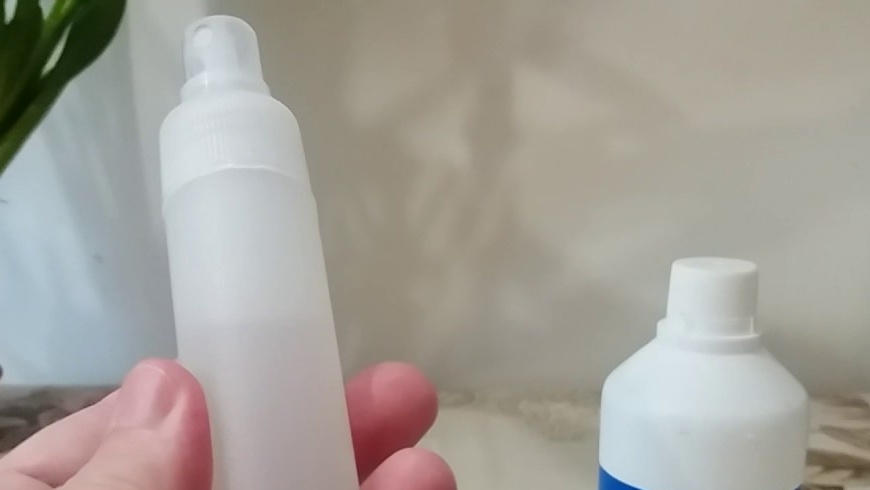 How to use hydrogen peroxide for orchids and why
How to use hydrogen peroxide for orchids and why Midges are wound up in the orchid: effective ways to get rid
Midges are wound up in the orchid: effective ways to get rid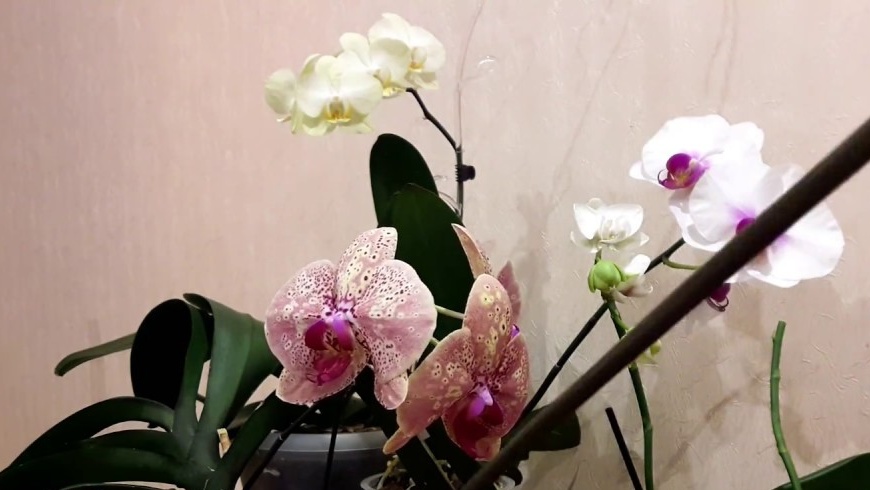 Is it possible to transplant an orchid during flowering
Is it possible to transplant an orchid during flowering